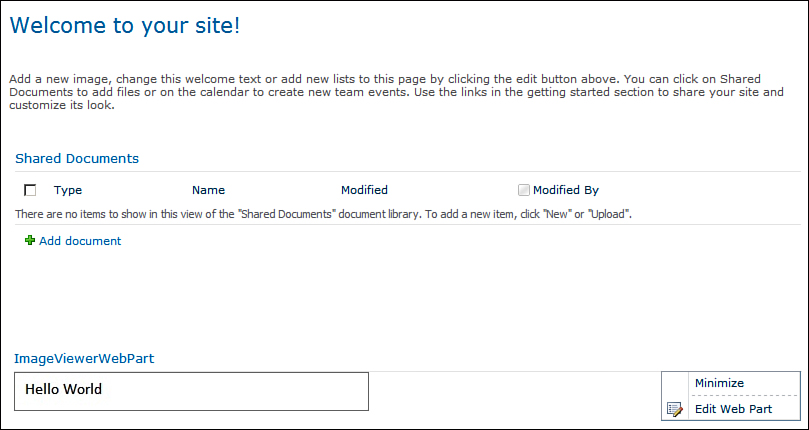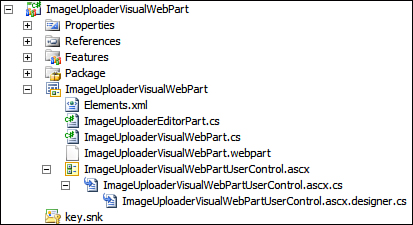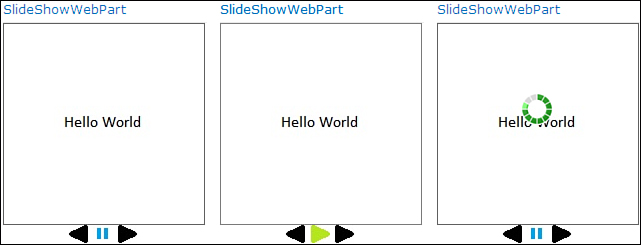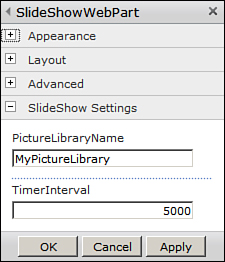Programming with Web Parts
The user and custom controls developed earlier had two limitations:
• They worked only for MyPictureLibrary, and there was no way an end user could configure the name of the picture library.
• Further, the end user could not add or remove these controls on just any page using the web browser.
Web parts offer a solution to these limitations, in an elegant and standardized way.
Web parts are specialized custom controls designed to support user customization. Web parts enable business users to manipulate content, appearance, and behavior of site pages using the web browser. Web parts are rendered inside Chrome, in the web part zones, on the web part pages. Chrome is responsible for providing a standardized user experience when dealing with web parts.
Web parts are managed by the Web Part Manager. Web Part Manager is responsible for serializing and deserializing web parts to the content databases, managing web part functionality as well as the web part events. The SPWebPartManager class provides implementation of Web Part Manager in the SharePoint world.
The concept of web parts was first introduced in WSS 2.0 and later on adopted in ASP.NET. The legacy WebPart class is still bundled with SharePoint 2010 and is present in the Microsoft.SharePoint.WebPartPages.WebPart namespace.
Web part definitions are stored in SharePoint in the form of XML-based template files. The template file contains information required by the Web Part Manager to create an instance of the web part. The document library where these files are stored is called the Web Part Gallery. Every site collection has exactly one Web Part Gallery, existing at the top level site.
The Image Viewer Web Part
To further understand how web parts solve the issues discussed in the beginning of this section, let’s convert the Image Viewer custom control to an Image Viewer web part, which extends the WebPart class present in the System.Net.Web.UI.WebControls.WebParts namespace.
The web part resembles the custom control developed earlier; however, now it is rendered inside Chrome, which provides additional things such as a border and a toolbar with a menu. In addition to these visual elements, you can now add or remove the web part using the browser on any of the site pages. The important point to note here is that you get all these additional goodies for free, by just inheriting from the WebPart class instead of the Control class earlier.
As you dirty your hands with web part development, it is possible that you create a web part that causes your entire page to crash because of a missing null check or an unhandled exception, for example. In such scenarios you can navigate to the Web Part Maintenance page and remove the defective web part from the page. You can navigate to the Web Part Maintenance page by adding Contents=1 to the web part page URL.
For example, to view the Web Part Maintenance page for the http://<< yourservername >>/SitePages/Home.aspx page, you can use the following URL:
http://<< yourservername >>/SitePages/Home.aspx?Contents=1
Moving from a custom control to web part has already solved our second issue (listed in the beginning of this section), that is, the end users can add or remove the web parts to a site page using a web browser. To solve the other issue—allowing users to easily configure the name of the picture library—let’s look at the idea of customization and personalization.
Customization and Personalization
There are two ways you can modify properties of a web part. Customization (or the shared view modification) refers to a change by a privileged user that is visible to and affects all users. Personalization (or the user view modification) on the other hand affects only the user doing the change and does not affect the view of other users.
Let’s create a new property, PictureLibraryName, and let end users configure this using the web browser. Decorate this property with the following three attributes:
• Personalizable(PersonalizationScope.Shared)
• WebBrowsable
• Category(“Configuration”)
The WebBrowsable attribute ensures that the property is visible in the Web Part editor and the Category specifies the group name under which the property appears in the Web Part editor.
Build and deploy the solution using Visual Studio and navigate to the site page where you added your web part earlier. Notice that the web part prompts you with a message to configure the picture library, as shown in Figure 5.8.
Figure 5.8. Prompt to configure the picture library
Use the Edit Web Part option provided by the menu in the web part Chrome, to edit the web part. The Web Part editor should now display your property under the Configuration category as shown in Figure 5.9.
Figure 5.9. Configuring the picture library in the Web Part editor
Enter the name of a picture library, created at the top-level site and click OK to save your changes. The web part should now display the images in the configured picture library. Notice that even if you close and open the web browser and navigate to the same page, your changes are persisted. The Web Part Manager is now responsible for repopulating your configuration (that is, the picture library name) every time you reload the page.
Configuring Web Parts with Editor Parts
Although things worked well with the web part so far, there is still one thing missing in the web part configuration. While configuring the picture library name, the user is free to enter anything in the text box as we are not doing any sort of validations against the picture library name. Additionally, rather than having validation logic in place, it would be even better if you can show a drop-down list of values to the users so that there is very little chance of making a mistake. The editor parts help us to achieve exactly the same effect.
Editor parts are specialized web controls meant for designing property editing interfaces. Let’s examine the process of developing an editor part to edit our Picture Library Name property in a more elegant and user friendly way.
All your editor parts should inherit from the System.Web.UI.WebControls.WebParts.EditorPart class. The System.Web.UI.WebControls.WebParts class provides you with an option to override the CreateEditorParts method, which you can override and return an EditorPartCollection containing your list of editor parts (with each editor part inheriting from the EditorPart class) along with the EditorPartCollection returned by the base class, as shown in the following code:
public override EditorPartCollection CreateEditorParts()
{
// Get the base editor part collection
EditorPartCollection baseCollection = base.CreateEditorParts();
// Create new ImageViewerEditorPart object
ImageUploaderEditorPart imageViewerEditorPart = new
ImageUploaderEditorPart();
imageViewerEditorPart.ID = "ImageViewerEditorPart";
// Create new ImageViewerEditorPart list, multiple custom editor parts
// can be added to the list
List<EditorPart> editorPartList = new List<EditorPart>();
editorPartList.Add(imageViewerEditorPart);
// Return new EditorPartCollection passing on the
// references to base collection and
// our newly created editor part list
return new EditorPartCollection(baseCollection, editorPartList);
}
In this code, ImageViewerEditorPart is the custom editor part created by inheriting from the EditorPart class.
To create an editor part, at the minimum, you should override the following methods of the EditorPart base class:
• CreateChildControls
• OnPreRender
• SyncChanges
• ApplyChanges
The following discusses the implementation of each of these methods, to create the ImageViewerEditorPart:
• CreateChildControls—In this method we create two child controls, a literal control to show the caption Select a Picture Library and a drop-down list to display available picture libraries in the top-level site and add these controls to the controls collection of the editor part.
• OnPreRender—The OnPreRender method contains the core functionality of the editor part. Here we check whether the count of items in the drop-down list is zero. If it is, then we populate it with the list of picture libraries. If the list is already populated, we call the SyncChanges method to synchronize the selected value in the drop-down list with the picture library name value returned web part.
• SyncChanges—Sets the selected value in the picture library drop-down list.
• ApplyChanges—Applies the user selection to the web part.
Refer to the code samples for this hour for implementation details.
Note that if you carefully examine the editor part you see two configuration sections for the picture library name setting, as shown in Figure 5.10. This is because, although we added an editor part to allow users to configure the value via the drop-down list, we still did not remove the WebBrowsable attribute from the PictureLibraryName property.
Figure 5.10. Two configuration sections to configure the picture library name
Since now you are controlling the modifications to the property via your editor part, there is no need to make the property WebBrowsable; therefore, we can safely remove this attribute now. As soon as you do so and redeploy the solution, the configuration section containing the text box to specify the picture library name will no longer appear in the web part editor.
Programming with Visual Web Parts
Visual web parts, as the name suggests, aim to ease the process of designing the user interface for the web parts, by leveraging Visual Studio’s design time support for user interface creation. To achieve this effect, visual web parts combine the functionalities offered by user controls with the web parts. A visual web part contains a user control and an associated code behind the file, and a class inheriting from the web part class (which acts as a wrapper for the user control), in addition to other files created in a standard web part project element. Visual Studio 2010 provides a project template as well to create visual web parts. This project can only be deployed as a farm solution, since the associated user control template file must be deployed to the CONTROLTEMPLATES folder under the SharePoint root (or the 14 hive). Visual web parts are useful in scenarios where you have a user interface with many child controls. Controlling the layout and rendering of child controls can be challenging in such scenarios, thus increasing the need for design time support to create the visual elements of the control.
Did you know that traditionally SharePoint developers have used the user control technique to build web parts? The user interface elements were placed in a user control and a wrapper web part was written to load the same. It was, however, in Visual Studio 2010 that a Visual Web Part template was first introduced and the concept was formalized.
Developing Connected Web Parts
All the web parts you developed so far operate in isolation, completely unaware of the existence of other web parts on a page. However, this concept of working in isolation might not work well in real-world scenarios. Consider a scenario in which a business user working on a sales report, which displays all the products with corresponding sales figures in tabular form, wants to view details for a selected product adjacent to the main report, on the same screen. If you were to develop two web parts working in isolation, one to display the sales report and the other to display product details, the details web part would never know what product has been selected by the business user in the sales report web part. This scenario calls for establishing a connection between web parts, so that you can pass the information related to selected product (which can be, say, a selected product ID) from the sales report web part to the product detail web part. Now when the business user selects a product in the sales report, the selected product value would be passed on to the product details web part, which would refresh its content to display the selected product details.
You can connect two or more web parts together by using web part connections. Web parts connected via the web part connections are labeled as connected web parts. A web part connection is established from a web part, which acts as a connection provider to a web part acting as a connection consumer. When a user adds a connection provider and a connection consumer web part on a page, it is the job of the web part manager to discover the compatible web parts and provide the user with an option to establish a connection. Connectable web parts share a common underlying interface definition. The connection provider implements this common interface, and by making use of interface methods and properties, the consumer can access the provider.
The ConnectedWebParts project in the accompanying source code for this hour highlights implementation details for the important steps involved in creating connected web parts. The interface IConfigurationProvider, defines two properties, the values for which are passed on from the ConfigurationProdiver web part to the ConfigurationConsumer. Consider the following interface definition:
public interface IConfigurationProvider
{
string PictureLibraryName { get; set; }
string ImageFileName { get; set; }
}
The ConfigurationConsumer web part uses these two properties to display the configured image from the picture library. The configuration provider implements this interface and provides values of the properties to the consumer. Apart from implementing the interface, the configuration provider also needs to define a function decorated with the ConnectionProvider attribute to provide the web part manager an instance of class implementing the IConfigurationProvider interface. Since in this case, the configuration provider is itself implementing the IConfigurationProvider interface, the function simply returns a reference to the ConnectionProvider class’s instance, as shown here:
[ConnectionProvider("Image Configuration", AllowsMultipleConnections = true)]
public IConfigurationProvider ConfigurationProviderConnectionPoint()
{
return this;
}
Setting AllowMultipleConnections allows the configuration provider to connect to multiple consumers. This seems a possible scenario, where consumer multiple web parts may want to connect to the provider to get the Image Configuration data.
Similarly the consumer must define a method decorated with the ConnectionConsumer attribute and accepting a reference to the interface object as a parameter, as shown in the following code:
[ConnectionConsumer("Image Configuration", AllowsMultipleConnections = false)]
public void ConfigurationProviderConnectionPoint
(IConfigurationProvider configurationProvider)
{
this.configurationProvider = configurationProvider;
}
Since it doesn’t make sense for the consumer to receive Image Configuration from multiple providers (as it can display only one image at a time in this case), set the AllowsMultipleConnections to false.
Be aware of the fact that since it is the end user who ultimately creates connections between the web parts there might be scenarios in which the consumer web part is not connected to any source. In such cases, it is important to do a null check before accessing any of the provider’s properties; otherwise, you might end up with an object reference not set to an instance of an object exception.
With this, your Connection Consumer and Connection Provider web parts are ready to use. Simply add both to a site page and edit the web parts. As shown in Figure 5.12, you should now have an option to connect the web parts by using the Connections menu item.
Figure 5.12. Connected web parts
Once a connection is established, the Connection Consumer displays the configured image.
Developing Ajax Web Parts
AJAX, or Asynchronous JavaScript and XML, is a web development technique for creating interactive web applications. AJAX improves “perceived” performance using asynchronous partial page updates, resulting in a better user experience. All the controls and web parts developed so far, cause the entire page to post back and reload to perform an operation on the server. This is fine in scenarios where your web part’s contents are mostly static and require less user interaction. However for web parts that take time to load, or are highly interactive, frequent postback and page load delays can degrade the user experience. For example, in the case of a slideshow web part (which you develop next), if the user wants to refresh the contents automatically, say, once every 5 seconds, doing a full page postback and reload results in a lot of flickering and a poor user experience. In scenarios like these ASP.NET AJAX comes to the rescue by enabling partial page updates so that only the contents inside the slideshow web part are refreshed and not the entire container page.
Developing web parts with ASP.NET AJAX in SharePoint 2007, required developers to perform a number of activities, before they could begin with the actual web part development; these included registering a number of libraries in web.config, programmatically adding script manager to their code, and so on. In SharePoint 2010 things have changed considerably and ASP.NET AJAX is now supported out of the box.
As you dirty your hands with AJAX development, you will discover that to achieve performance benefits on the server side, developers often develop an underlying script service (consumed directly by the client) and provide the contents for partial page updates. The slideshow web part created in this hour serves as a really good example to break the ice and get you started with AJAX development.








